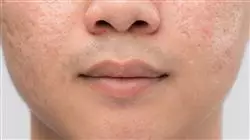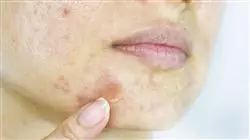University certificate
The world's largest faculty of medicine”
Introduction to the Program
The management of acne explained in a highly efficient Master’s Degree, with a practical approach of great educational value”

Understanding the pathophysiology of acne is key to being able to prescribe the appropriate treatment for each individual patient, given the clinical polymorphism of this disease. Each medication will act on one or more of the pathogenic pillars of acne and, depending on the predominance of retention-related or inflammatory lesions, will be more or less effective.
In addition, in recent years, the active and key role of certain etiological agents that were not previously considered so important has been discovered.
In recent years, discoveries have been made in the inflammatory cascade and in the mediators involved, opening the way to the development of new medicines targeting these inflammatory reactions.
Topical treatments will be the mainstay in many mild cases, and will complement systemic treatments in more severe cases. In addition to the topical medications themselves, it is very important to know which cosmetics are the most suitable for acne-prone skin.
Oral antimicrobials are the mainstay of treatment in many moderate to severe cases in which inflammatory lesions are predominant. As with their topical application, the treatment of acne with oral antibiotics is one of the causes of the increase in the rate of bacterial resistance. For this reason, treatment regimens should be optimized, combining them with other drugs that reduce the risk of resistance and minimizing the duration of the cycles.
Hormonal treatment is very effective in women with acne, especially when there is more evidence of hyperandrogenism. Numerous oral hormonal contraceptives are available, most of them with combinations of two active ingredients. It is necessary to know them, as some will be very beneficial in these patients, but others may significantly worsen their acne.
A comprehensive compendium of knowledge that will cover these and other essential issues in the treatment of acne.
The latest advances in the field of acne compiled in a Master’s Degree of great educational value, which will optimize your efforts and produce the best results"
This Master’s Degree in Acne Treatment contains the most complete and up-to-date scientific program on the market. The most important features include:
- Development of a Large Number of Case Studies Presented by Experts
- Graphic, schematic, and highly practical contents
- The latest developments and cutting-edge advances in this area
- Practical exercises where the self-evaluation process can be carried out to improve learning
- Innovative and highly efficient methodologies
- Theoretical lessons, questions to the expert, debate forums on controversial topics, and individual reflection assignments
- Content that is accessible from any fixed or portable device with an Internet connection
Discover a new way to keep yourself up-to-date and position yourself at the forefront of the medical field with this highly demanding master’s degree”
The development of this course is focused on practicing the proposed theoretical learning through the most effective teaching systems and proven methods which have been adopted from the most prestigious universities in the world. You will be able to acquire new knowledge in an eminently practical way, safe in the knowledge that TECH strives to convert their student’s efforts into tangible skills for the working world.
TECH’s online system is another of the strengths of its educational catalogue,with an interactive platform that takes advantage of the latest technological developments, the most interactive digital tools are made available. In this way, it is possible to offer a form of learning that is totally adaptable to the needs of the students, so that they can perfectly combine this specialization with their personal and working lives.
Everything a professional needs for an effective approach to the field of acne presented in a thorough yet unique Master’s Degree"

A training program created to allow you to implement your acquired knowledge into your daily practice almost immediately"
Why study at TECH?
TECH is the world’s largest online university. With an impressive catalog of more than 14,000 university programs available in 11 languages, it is positioned as a leader in employability, with a 99% job placement rate. In addition, it relies on an enormous faculty of more than 6,000 professors of the highest international renown.

Study at the world's largest online university and guarantee your professional success. The future starts at TECH”
The world’s best online university according to FORBES
The prestigious Forbes magazine, specialized in business and finance, has highlighted TECH as “the world's best online university” This is what they have recently stated in an article in their digital edition in which they echo the success story of this institution, “thanks to the academic offer it provides, the selection of its teaching staff, and an innovative learning method aimed at educating the professionals of the future”
A revolutionary study method, a cutting-edge faculty and a practical focus: the key to TECH's success.
The most complete study plans on the university scene
TECH offers the most complete study plans on the university scene, with syllabuses that cover fundamental concepts and, at the same time, the main scientific advances in their specific scientific areas. In addition, these programs are continuously being updated to guarantee students the academic vanguard and the most in-demand professional skills. In this way, the university's qualifications provide its graduates with a significant advantage to propel their careers to success.
TECH offers the most comprehensive and intensive study plans on the current university scene.
A world-class teaching staff
TECH's teaching staff is made up of more than 6,000 professors with the highest international recognition. Professors, researchers and top executives of multinational companies, including Isaiah Covington, performance coach of the Boston Celtics; Magda Romanska, principal investigator at Harvard MetaLAB; Ignacio Wistumba, chairman of the department of translational molecular pathology at MD Anderson Cancer Center; and D.W. Pine, creative director of TIME magazine, among others.
Internationally renowned experts, specialized in different branches of Health, Technology, Communication and Business, form part of the TECH faculty.
A unique learning method
TECH is the first university to use Relearning in all its programs. It is the best online learning methodology, accredited with international teaching quality certifications, provided by prestigious educational agencies. In addition, this disruptive educational model is complemented with the “Case Method”, thereby setting up a unique online teaching strategy. Innovative teaching resources are also implemented, including detailed videos, infographics and interactive summaries.
TECH combines Relearning and the Case Method in all its university programs to guarantee excellent theoretical and practical learning, studying whenever and wherever you want.
The world's largest online university
TECH is the world’s largest online university. We are the largest educational institution, with the best and widest online educational catalog, one hundred percent online and covering the vast majority of areas of knowledge. We offer a large selection of our own degrees and accredited online undergraduate and postgraduate degrees. In total, more than 14,000 university degrees, in eleven different languages, make us the largest educational largest in the world.
TECH has the world's most extensive catalog of academic and official programs, available in more than 11 languages.
Google Premier Partner
The American technology giant has awarded TECH the Google Google Premier Partner badge. This award, which is only available to 3% of the world's companies, highlights the efficient, flexible and tailored experience that this university provides to students. The recognition as a Google Premier Partner not only accredits the maximum rigor, performance and investment in TECH's digital infrastructures, but also places this university as one of the world's leading technology companies.
Google has positioned TECH in the top 3% of the world's most important technology companies by awarding it its Google Premier Partner badge.
The official online university of the NBA
TECH is the official online university of the NBA. Thanks to our agreement with the biggest league in basketball, we offer our students exclusive university programs, as well as a wide variety of educational resources focused on the business of the league and other areas of the sports industry. Each program is made up of a uniquely designed syllabus and features exceptional guest hosts: professionals with a distinguished sports background who will offer their expertise on the most relevant topics.
TECH has been selected by the NBA, the world's top basketball league, as its official online university.
The top-rated university by its students
Students have positioned TECH as the world's top-rated university on the main review websites, with a highest rating of 4.9 out of 5, obtained from more than 1,000 reviews. These results consolidate TECH as the benchmark university institution at an international level, reflecting the excellence and positive impact of its educational model.” reflecting the excellence and positive impact of its educational model.”
TECH is the world’s top-rated university by its students.
Leaders in employability
TECH has managed to become the leading university in employability. 99% of its students obtain jobs in the academic field they have studied, within one year of completing any of the university's programs. A similar number achieve immediate career enhancement. All this thanks to a study methodology that bases its effectiveness on the acquisition of practical skills, which are absolutely necessary for professional development.
99% of TECH graduates find a job within a year of completing their studies.
Master's Degree in Acne Treatment
Acne is a skin condition that causes comedones, papules and pustules in the facial area and upper trunk. This disease is usually common, since, according to the Spanish Association of Pediatrics, it affects 80% of the adolescent population with an average age between 13 and 18 years old. As it is a visibly noticeable problem, it affects not only physical health, but also emotional health, causing psychological disorders or low self-esteem. This is why, over the years, scientific and technological advances have emerged that contribute to treat this pathology by means of different innovative techniques. With the aim of providing health personnel with the necessary knowledge to delve deeper into this subject, TECH has developed a Master's Degree in Acne Treatment which, in addition to delving into the most advanced procedures in the current medical panorama, covers the clinical polymorphism of this disease. Professionals who wish to specialize in this area will find in this program all the elements required to obtain a quality education. They will study topics ranging from the management of topical, hormonal and light source treatments; to the implementation of appropriate diets, the use of oral antimicrobials and systemic retinoids according to current scientific evidence.
Be an expert in treating acne
As a result of medical advances, new drugs have emerged to treat inflammatory reactions and retentional lesions; this, in turn, is complemented by topical and chemical peel treatments that contribute to the improvement of both mild and severe cases. During a year of training guided by the best specialists in the field, you will learn the pathophysiological basis of acne to properly address the mechanisms of action, recommended guidelines and possible side effects caused by topical and oral antibiotics. You will be able to diagnose secondary conditions or special conditions such as neonatal acne, pregnancy and lactation, which require a specific procedure to manage the aesthetic sequelae through the best available options. Because of this, you will be able to treat patients not only in the predominant age group, but also in adults, since, according to the Spanish Academy of Dermatology and Venereology (AEDV), it is estimated that between 12 and 15% of women and 2% of men suffer from acne in adulthood.







